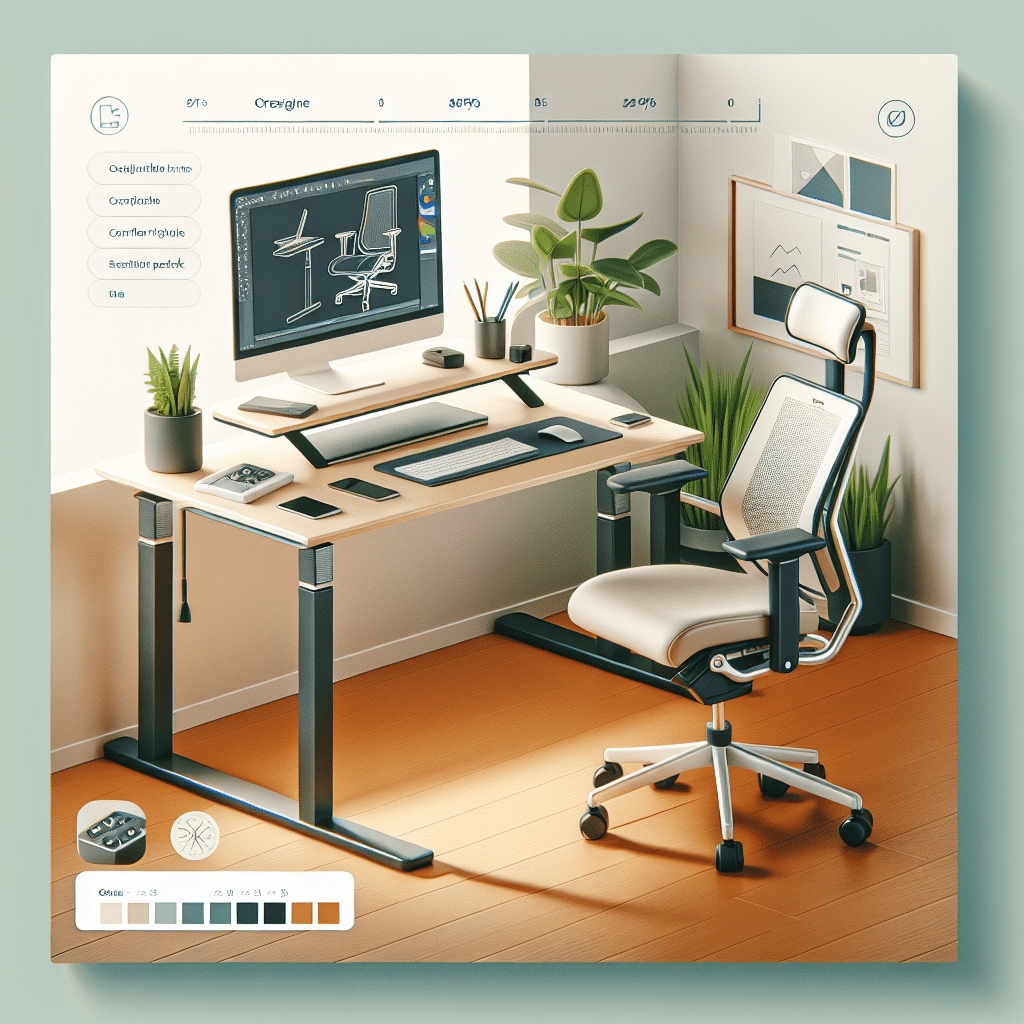Understanding Ergonomics: The Foundation of Comfort
Ergonomics is about finding the optimal balance for your workspace. Unlike traditional desks, standing desks can lead to greater well-being and productivity if used correctly. To make the most of your standing desk, incorporate tips that consider height adjustments, screen placement, and accessories.
Choose the Right Standing Desk Height
-
Height Adjustments:
- When standing, your desk should be set to allow your elbows to be at a 90-degree angle or slightly obtuse. This positioning prevents strain on your shoulders.
- The keyboard and mouse should be at a height that keeps your wrists straight and your hands level.
-
Screen Height:
- Your monitor should be at eye level, about 20 to 30 inches from your face. This distance helps reduce eye strain and keeps your neck in a neutral position.
- Use a monitor stand or a stack of books to raise your screen to the proper height.
Utilize Ergonomic Chairs
-
Chair Height and Position:
- An ergonomic chair should allow your feet to rest flat on the ground or on a footrest, with your knees at hip level or slightly lower.
- Adjust the seat depth so that there’s a two- to three-finger gap between the back of your knees and the seat.
-
Support Your Lumbar Region:
- Look for a chair with adjustable lumbar support to maintain the natural curve of your spine.
- Consider using lumbar rolls or cushions if your chair lacks adequate support.
Footwear Matters
-
Wear Supportive Shoes:
- Shoes should provide support and cushioning, especially if you spend long hours standing. Opt for footwear with arch support and shock absorption.
- Avoid high heels or flip-flops that can lead to discomfort and foot fatigue.
-
Consider Insoles:
- Invest in quality insoles designed for standing desks that provide additional comfort and support.
Movement is Key
-
Frequent Movement:
- Alternate between sitting and standing regularly. Experts recommend changing positions every 30 to 60 minutes.
- Use reminders or apps to prompt you to change your posture.
-
Incorporate Small Exercises:
- Simple stretches or leg lifts can help maintain circulation and reduce stiffness while working. Make it a point to move at least once every hour.
-
Use an Anti-Fatigue Mat:
- An anti-fatigue mat provides cushioning for your feet, reducing discomfort and fatigue while standing. This can be especially beneficial for long hours at the desk.
Design Your Workspace for Comfort
-
Desk Arrangement:
- Design your workspace to minimize strain: Arrange your monitor, keyboard, and mouse in a straight line and keep frequently used items within arm’s reach.
-
Personalize Your Setup:
- Surround yourself with items that promote comfort and reduce stress. Plants can improve air quality and boost mood, while personal touches can make your workspace inviting.
Manage Your Monitor Settings
-
Adjust Brightness and Contrast:
- Configure your monitor’s brightness to match the ambient lighting of your workspace. This can help reduce eye strain.
- Adjust the contrast settings to ensure clear visibility without straining your eyes.
-
Use Blue Light Filters:
- Blue light can adversely affect sleep and contribute to eye strain. Consider using a blue light filter on your screen or wearing glasses designed to block blue light.
Stay Hydrated and Nourished
-
Keep Water Nearby:
- Staying hydrated is crucial for maintaining energy levels and focus. Keep a water bottle at your desk to encourage regular hydration breaks.
-
Healthy Snacks:
- Stock healthy snacks, such as nuts, fruits, or low-sugar energy bars, to keep your energy levels stable throughout the day.
Monitor Your Posture
-
Mind Your Position:
- Maintain a neutral spine and avoid leaning forward or slumping. Your shoulders should be relaxed and your elbows close to your body.
- Set reminders to check your posture throughout the day.
-
Use Desk Accessories:
- A document holder can help maintain proper ergonomics when reading or typing.
Invest in Technology
-
Consider a Sit-Stand Converter:
- If you’re not ready to buy a new standing desk, a converter can transform your existing desk into a sit-stand setup, allowing flexibility.
-
Track Your Movements with Apps:
- Various apps can track standing vs. sitting time, helping you stay accountable and motivated to move more.
Employee Wellness Programs
-
Participate in Wellness Challenges:
- Many companies offer wellness challenges promoting standing and activity. Engage in these programs for social motivation and support.
-
Education:
- Participate in workshops focused on ergonomics and healthy workspace practices to remain informed about the best practices.
Seek Professional Guidance
-
Consult an Ergonomics Expert:
- If discomfort persists, consider consulting an ergonomist or physical therapist who can provide tailored recommendations for your workspace.
-
Regular Check-Ups:
- Maintain regular health check-ups to monitor musculoskeletal health, especially if you experience chronic pain.
Final Thoughts on Comfort Optimization
In enhancing comfort in your standing desk and ergonomic chair setup, it’s crucial to listen to your body. What works for one person may not work for another, making customization essential. By adjusting your workspace and adopting healthy habits, you can significantly increase your productivity and well-being while reducing discomfort. Prioritize ergonomics, stay mobile, and cultivate an inviting workspace to reap the benefits of these health-conscious improvements.
